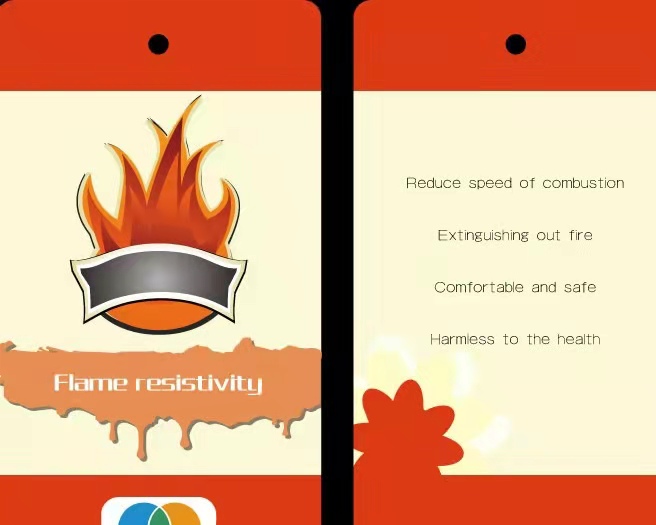
Product traits and technical indicators
High-efficiency flame-retardant finishing agent SCJ-928, environmentally friendly, non-toxic, non-corrosive, free of halogen elements, formaldehyde, antimony and heavy metals and other harmful ingredients, easy to use, good flame retardant effect, suitable for natural and chemical fiber fabrics It is also suitable for flame retardant treatment of interior decoration materials such as carpets, curtains, wall coverings (paper), sofa covers, bedding, etc. used in hotels, public entertainment places, automobiles, etc., as well as fire prevention of curtains, tents, wood and paper Flame retardant finishing. It is especially suitable for non-durable flame-retardant finishing of cotton fabrics.
The material processed by the flame retardant finishing agent SCJ-928 can provide safe and reliable fire protection. The flame retardant performance has reached the national standard "Flame Resistant Class B1", in line with GB5454-1997 "Determination of Textile Combustion Performance, Oxygen Index Method", GB5455-1997 " Determination of the burning performance of textiles, vertical burning method, GB8624-2012 "Classification method for burning performance of building materials", GB50222-95 "Code for fire protection design of interior decoration of buildings", GB8410-2006 "Combustion characteristics of automotive interior materials", HB 5470- 2014 "Requirements for the combustion performance of non-metallic materials in the cabin of civil aircraft", TB/T 3138-2006 "Technical requirements for flame-retardant materials for locomotives and vehicles" and other standards.
Flame Retardant Technical Index
High-efficiency flame-retardant finishing agent SCJ-928 is white powder in appearance, with a solid content of more than 98%, soluble in water, PH=5-6, relative density 1.69, melting point 192°C. After the flame-retardant treatment, it has no adverse effect on the feel and color of the fabric. The oxygen index is greater than 32%; the continuous burning time is less than 5S; the flame-retardant time is less than 5S; the damage (carbonization) length: less than 150mm. It does not contain formaldehyde, APEO, halogen elements, heavy metals and aromatic amines, and complies with REACH regulations, Oeko-Tex 100 and GB18401-2010 and other environmental safety and ecological standards.
Instructions
Chemical operation: SCJ-928 flame retardant finishing agent 1Kg, add about 5 to 15Kg of water (40~80℃ hot water or hot deionized water is preferred), stir and dissolve.
1. Padding process:
Fabric →Padding flame retardant liquid (two dip and two rolling, SCJ-928 flame retardant finishing agent 50~150g/L, rolling rate 70-80%)→drying (80~120℃)
2. Dipping process:
The material is immersed thoroughly in the flame retardant liquid (SCJ-928 flame retardant finishing agent 50~150g/L), dehydrated (recovered and thrown out the residual liquid), and then dried or dried.
3. Spraying process:
SCJ-928 flame retardant finishing agent 100-200 g/L is directly sprayed on curtains, wallpapers, sofas, carpets and other decorative fabrics and absorbent materials, and good flame retardant effects can be obtained after drying or drying. Usually use a sprayer to spray uniformly on the front and back of the material repeatedly, spray it until it is soaked, and then dry or dry it.
Precautions:
1. The above formulas and processes are for reference only. Thin fabrics use high-concentration formulas, thick and dense fabrics use low-concentration processes, please make appropriate adjustments according to the different fabric specifications (in the case of the same yarn count: usually the density is doubled, and the flame retardant concentration is increased Double), the specific decision must be made after a sample experiment.
2. Thin fabrics and velvet fabrics need to increase the concentration of flame retardant finishing agent SCJ-928, even reaching 200g/L;
3. Thick and dense fabrics can reduce the concentration of flame retardant finishing agent SCJ-928, even as low as 50g/L. The specific concentration is adjusted according to the sample test and test results.
4. The fabric needs to improve the binding fastness of the flame retardant finishing agent SCJ-968, and the fixing agent SLT 50-100g/L can be added.
5. It is required that the fabric surface of the fabric to be treated has high wool efficiency, removes impurities and instantly absorbs water. The low wool efficiency of the fabric will reduce the flame-retardant finishing effect, which can be partially compensated by using 60-80℃ warm hydrated material, multiple padding and multiple rolling.
Packaging and storage: 25kg plastic woven bag, stored in a cool warehouse, storage period of one year.
